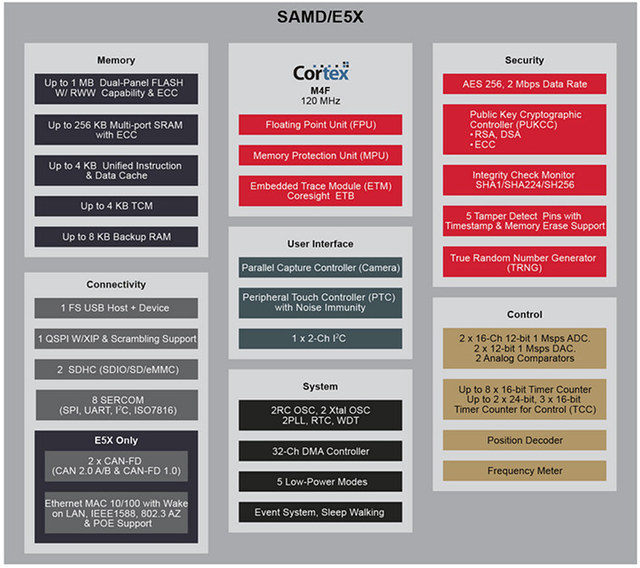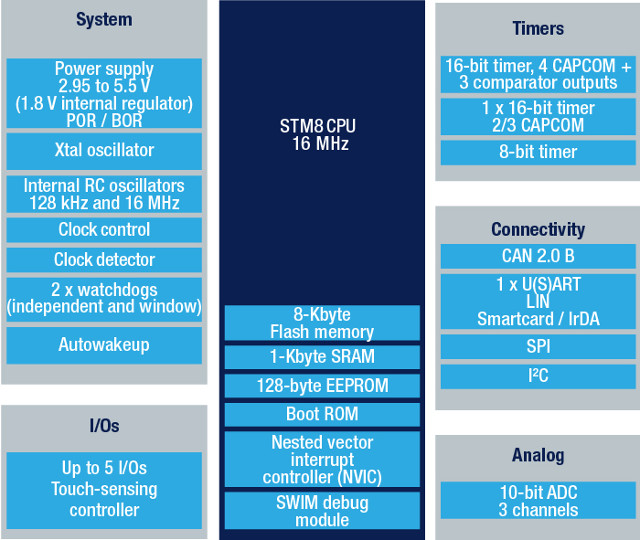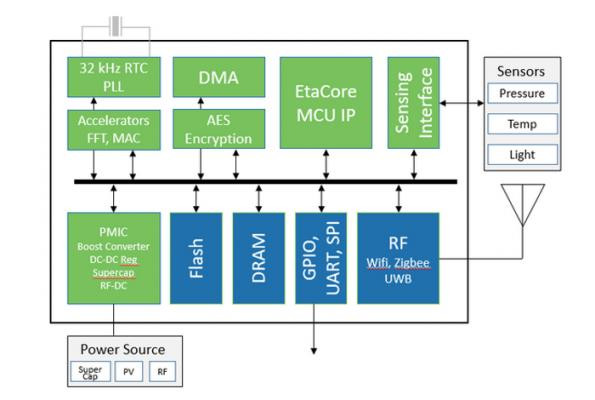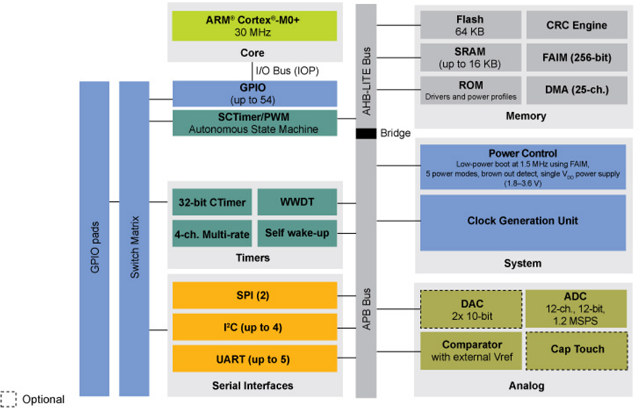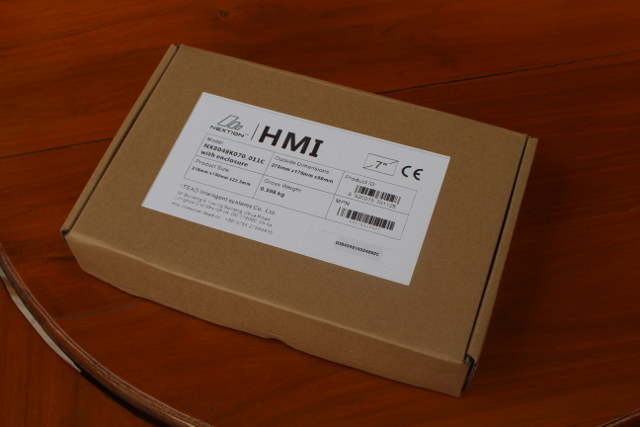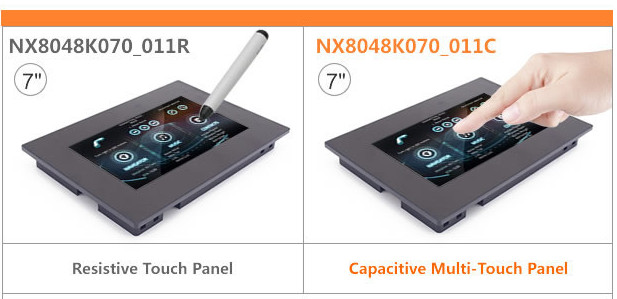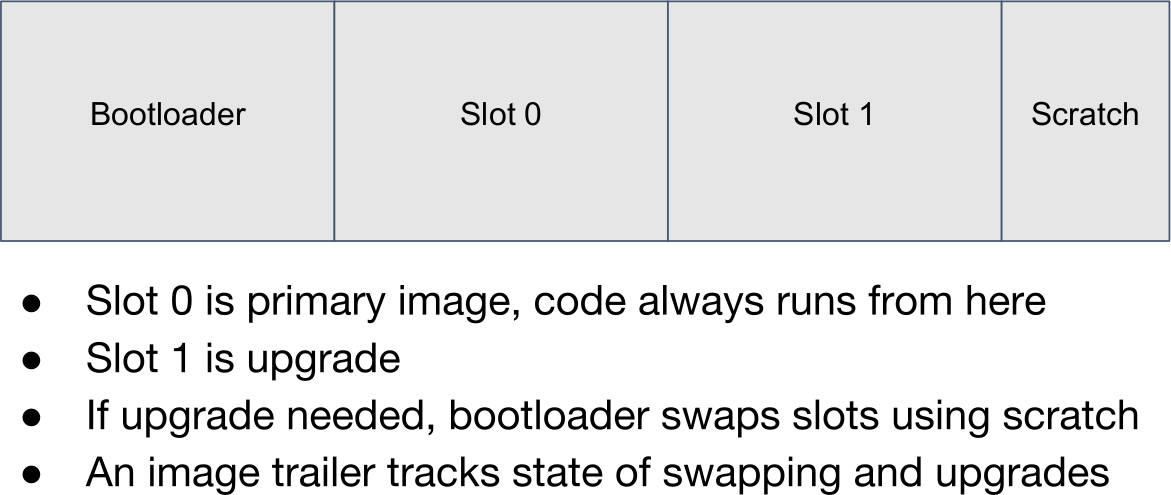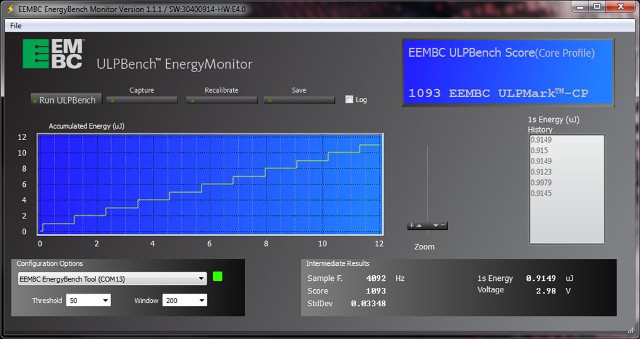Microchip has just introduced two new families of micro-controllers based on ARM Cortex-M4F with SAM D5x and SAM E5x series sporting up to 1 MB of dual-panel flash and 256 KB of SRAM both with ECC support. Both families also support QSPI flash with XIP (eXecute In Place) support, features an SD card controller and a capacitive touch controller, with SAM E5x family also adding support for two CAN-FD ports and Ethernet. Microchip SAM A5x/E5x key features and specifications: MCU Core – ARM Cortex-M4F core running at 120 MHz with single precision Floating Point Unit (FPU) Memory – Internal memory architecture with user configurable Tightly Coupled Memory, System memory, Memory Protection Unit and 4KB Combined I-cache and D-cache; up to 256KB ECC SRAM, up to 1MB ECC flash Storage I/F – Quad Serial Peripheral Interface(QSPI) with Execute in Place (XIP) Support Peripherals Up to 2x Secure Digital Host Controller (SDHC) […]
STMicro Introduces 20 Cents STM8S001J3 8-Bit MCU in 8-Pin Package
STMicro has launched a new 8-bit micro-controller that sells for $0.20 per unit in 10k quantities, a price not too far from the one of cheapest MCU, especially considering it comes with flash. STM8S001J3 is also the first STM8 MCU offered in 8-pin package (SO8N), and should compete with some of the Microchip Attiny or PIC12F series micro-controllers. STM8S001J3 specifications: Core – 16 MHz advanced STM8 core with Harvard architecture and 3-stage pipeline,extended instruction set System Memory – 1 Kbyte RAM Storage 8 Kbytes Flash memory; data retention 20 years at 55 °C after 100 cycles 128-byte true data EEPROM; endurance up to 100 k write/erase cycles Clock, reset and supply management 2.95 V to 5.5 V operating voltage Flexible clock control, 3 master clock sources: external clock input; internal, user-trimmable 16 MHz RC; internal low-power 128 kHz RC Clock security system with clock monitor Power management – Low-power modes […]
EtaCore ARM Cortex M3 Core Operates at Low Voltage (0.25V and up) for Higher Power Efficiency
We’ve previously seen Ambiq Micro offering Apollo ARM Cortex M4F MCU with Cortex M0+ energy efficiency, and later the upgraded Apollo 2 MCU with even lower power consumption and better performance. The company can achieve such efficiency thanks to low sub-thresold operating voltage in the 0 to 0.5V range. Another startup – Eta Compute – is now offering another low voltage solution with their EtaCore ARM Cortex M3 IP, and other IP blocks operating at low voltage (0.25 to 1.2V). Eta Compute claims a “10x improvement in power efficiency over any alternative”, and battery life of over 10 years on a CR2032 coin cell. Their website does not provide that many details about the core and development tools, but still mentions the following: The only commercially available self-timed technology supporting dynamic voltage scaling (DVS) that is insensitive to process variations, inaccurate device models, and path delay variations Includes M0+ and […]
NXP Unveils LPC84x ARM Cortex M0+ MCU Family, and LPCXpresso845-MAX Evaluation Board
NXP Semiconductors has expanded LPC800 series MCUs with the new LPC84x family of 32-bit ARM Cortex-M0+ microcontroller said to offer 10 times the performance, three times more power saving savings, and 50 percent smaller code-size than 8- or 16-bit microcontrollers. Key features of LPC84x MCU family (LPC844 / LPC845): MCU Core – ARM Cortex-M0+ core @ 30 MHz with advanced power optimization RAM – 16 kB RAM (Logic for Bit banding across all of SRAM) Storage – 64 kB Flash, small 64-byte page size suitable for EEPROM emulation Peripherals Timers – 32-bit CTimer, WWDT, 4-channel multi-rate, SCTimer/PWM Serial Interfaces – Up to 4x I2C, 2x SPI, up to 5x UART Analog Interfaces – 12 ch, 12-bit ADC up to 1.2 Msps; 2x 10-bit DAC; comparator with external Vreg; 9-channel capacitive touch interface working in sleep and deep sleep modes Up to 54 GPIOs 25-ch DMA offloads core Power Control Five […]
Mini Review of Nextion Enhanced NX8048K070 7″ Display with Enclosure for HMI Applications
I reviewed some Nextion touchscreen a while ago. Those were 2.4″ and 5″ serial TFT displays with optional resistive touch support that could be used in standalone mode, or connected to an MCU board over UART to control external hardware. The user interface could be designed and emulated in Windows based Nextion Editor program before uploading it to the display via UART or micro SD card. ITEAD Studio has recently launched Nextion Enhanced NX8048K070 family of 7″ displays with resistive or capacitive touch panels, and support for GPIOs. The company sent me the capacitive model with enclosure for evaluation, so I’ll have a quick look at the hardware and Nextion Editor in this mini review. Nextion Enhanced NX8048K070_011C Unboxing I received it in a package from “ITEAD intelligent solutions” with basic description with Model: NX8048L070_011C with enclosure Outside dimensions : 275 x 170 x 50 mm (That’s the package dimensions) […]
Nextion Enhanced NX8048K070 is a 7″ Resistive or Capacitive Programmable Touch Display with an Optional Enclosure
Nextion displays are designed to be controlled by MCU boards with the user interface designed in Nextion Editor drag-and-drop tool. ITEAD Studio launched them in 2015, and I played with Nextion 2.4″ and 5.0″ models, but at the time, I found the Windows only Nextion Editor program not to be that user-friendly and inconvenient to use, as for example, UI designs do not automatically scale across all display sizes. The company is now back with a 7″ model, available with resistive or capacitive touch panel, and featuring an ARM7 processor exposing 8 GPIOs. Nextion Enhanced NX8048K070 (_011) specifications: CPU – ARM7 processor @ 108 MHz with 8K RAM, 1024 EEPROM, 1024 bytes instruction buffer Storage – 32MB flash memory, micro SD card slot Display – 7″ TFT display with resistive or capacitive panel; resolution: 800×480; 65K colors; adjustable brightness: 0 to 230 nit Expansion – 8x GPIOs including 4x PWM, […]
MCUBoot is an Open Source Secure Bootloader for IoT / MCUs
Bootloaders takes care of the initial boot sequence on the hardware before the operating system takes over. For example, U-boot is often used in embedded systems as the bootloader before starting the main operating systems such as Linux or FreeBSD. MCUBoot is also a bootloader, but it targets the IoT, here referring to MCU based systems with limited memory and storage capacity, and is born out of work on Apache Mynewt OS, when developers decided to develop the bootloader separately from the operating system. MCUBoot is designed to run on small & low cost systems running on MCU with ~512 KB flash, ~256 KB RAM, and currently supports Zephyr OS and Mynewt, with support for other RTOS also considered. Due to constraint the bootloader uses minimal features with a flash driver, a single thread, and crypto services. The project also aims at solving security and field firmware updates. To address the […]
EEMBC IoT-Connect is a Family of Benchmarks Designed To Test the Power Efficiency of IoT Devices
EEMBC, the Embedded Microprocessor Benchmark Consortium, has been providing benchmarks for embedded systems since 1996, including ULPBench helping to rank micro-controllers by their power efficiency. But with the Internet of Things gaining traction, it’s important to test more than just the MCU core’s power efficiency, and having a benchmark taking sensors and connectivity into account would be useful. That’s exactly what EEMC IoT-Connect benchmark family aims for with the three main characteristics: Provides flexibility to accommodate various communication protocols (e.g. Bluetooth, Thread, LoRa, WiFi) Portable to work with any vendor’s microcontroller and radio-module products Compatible with EEMBC ULPBench and EEMBC IoT-Secure benchmarks The first benchmark of the family is IoTMark-BLE connectivity profile that supports Bluetooth (LE) MCUs. The benchmark requires fixed payload size, frequency of transmission, and transmit power, and performs a complete sequence of event ranging from sensor reading, to BLE notifications, and command write and CRC. The IoT-Connect […]


